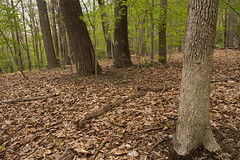Slope shape is one of the biggest factors influencing natural communities.
A concave slope is like a bowl: it accumulates soil and moisture. A convex slope is the opposite. Turn that bowl upside-down. What happens? Precipitation runs off quickly, carrying soil with it. Water that does soak in drains through the soil rapidly, taking some of the soluble plant nutrients with it, leaving the soils dry and infertile.
Adding to the differences, in many cases convex slopes are at higher elevation than nearby concave slopes, and are thus more exposed to wind, sun, and lightning strikes. Concave slopes are more likely to be at lower elevations, closer to the water table and groundwater seeps and springs that contain dissolved minerals that help plants grow.
 The slightly convex shape of this hilltop lends to the dry conditions and nutrient-depleted soil in this stand of Mixed Oak / Heath Forest at Rock Creek Park.
The slightly convex shape of this hilltop lends to the dry conditions and nutrient-depleted soil in this stand of Mixed Oak / Heath Forest at Rock Creek Park.
Photographer: Sam Sheline, courtesy of NatureServeIn general, hilltops and ridgetops are likely to be convex, while ravines and toeslopes are likely to be concave.
For all these reasons, convex slopes tend to have dry, infertile, and shallow soil that create challenging conditions for plants. Concave surfaces, on the other hand, tend to have deep, moist, fertile soils that support a wide variety of plant species.
Tip: To see an example of a concave slope, visit the Rock Creek Park Map Viewer. Type "slope" in the Search tool, and select Natural Highlights: Groundwater-influenced Slope on Valley Trail.


